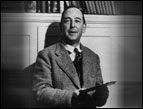Inspiration, Imagination, and Adventure
For C. S. Lewis, it all began with pictures in his head — startling visual images that gripped him, inspired him, and captured his imagination. Once — out of nowhere — he suddenly saw in his mind’s eye a picture of a faun carrying an umbrella and parcels in a snowy wood. Lewis was only sixteen at the time. But more than thirty years later, he still remembered the scene he had so vividly imagined. By this time Lewis had become a world-famous author and lecturer. He decided he would try to write a story about the picture. He jotted down a few ideas in his notebook. As he thought about it, other pictures began to appear before him: a queen on a sledge and a magnificent lion.
“Suddenly Aslan came bounding in,” Lewis later explained. “I don’t know where the Lion came from or why He came. But once He was there, He pulled the whole story together.”
As he sat down to write the book that would become The Lion, the Witch and the Wardrobe — the first book in the Chronicles of Narnia — Lewis drew from many of his own real-life experiences. He recalled how he and his brother Warnie used to climb up into an old wardrobe and tell each other stories about talking animals, magic kingdoms, knights, and dragons. Much later, a little girl visiting Lewis’s home asked him if there was anything behind the wardrobe he still kept there. Perhaps there was, Lewis thought. What if other worlds really did exist and you could get to them by stepping into a wardrobe? Lewis let his imagination soar.
A number of children had recently come to stay with Jack and Warnie and their housekeeper, Mrs. Moore. It was during World War II, and German fighter planes were conducting air raids against Great Britain. They dropped thousands of bombs on the most heavily populated cities. Whenever possible, parents sent their children to live with friends and relatives out in the country, where it was safer.
Of course, Lewis had no children of his own, and he hadn’t really spent any time with young people in years. But as he got to know the children who stayed in his home, Lewis discovered something that alarmed him. These children didn’t seem to know how to entertain themselves. They didn’t have much imagination at all. They didn’t read. And they were in way too much of a hurry to become adults. These children didn’t have any time for things they considered “baby-ish.”
Lewis understood. He had felt that way once — but he knew better now.
“When I was ten, I read fairy tales in secret and would have been ashamed if I had been found doing so,” he admitted. “Now that I am fifty, I read them openly. When I became a man I put away childish things, including the fear of childishness and the desire to be very grown-up.”
 Lewis thought of all the wonderful stories he loved to read as a child and how they impacted his life. It made him sad to think what the children of his day were missing. Yet there weren’t many contemporary books he could recommend to them—books that would not merely educate but encourage and inspire them. It was all the more reason Lewis should write stories of his own. “People won’t write the books I want, so I have to do it for myself,” he concluded.
Lewis thought of all the wonderful stories he loved to read as a child and how they impacted his life. It made him sad to think what the children of his day were missing. Yet there weren’t many contemporary books he could recommend to them—books that would not merely educate but encourage and inspire them. It was all the more reason Lewis should write stories of his own. “People won’t write the books I want, so I have to do it for myself,” he concluded.
Lewis’s first children’s book began with the sentence, “Once there were four children whose names were Peter, Susan, Edmund and Lucy.”
Peter was the name of the talking-mouse hero of all the stories he had written as a boy. Lucy was the daughter of Lewis’s good friend, Owen Barfield. In addition to naming one of the main characters after her, Lewis decided to dedicate the book to her as well:
My Dear Lucy,
I wrote this story for you, but when I began it I had not realized that girls grow quicker than books. As a result you are already too old for fairy tales, and by the time it is printed and bound you will be older still. But some day you will be old enough to start reading fairy tales again. You can then take it down from some upper shelf, dust it and tell me what you think of it. I shall probably be too deaf to hear, and too old to understand a word you say, but I shall still be your affectionate Godfather,
C. S. Lewis
In The Lion, the Witch and the Wardrobe, the four children are sent to stay at the country home of Professor Kirke. Lewis named the professor for his old tutor, W. T. Kirkpatrick. Kirkpatrick was a gruff but kindhearted man who always insisted his students must learn to use “logic” to carefully think things through. Of course in some ways the character of Professor Kirke was not unlike C. S. Lewis, who had become a professor himself.
While exploring the professor’s rambling country home, the children climb into a wardrobe to hide from the no-nonsense housekeeper, Mrs. Macready (Mrs. Moore). Inside the wardrobe, the children discover the magical world of Narnia.
As Lewis created Narnia, he drew on all the imaginary worlds described by the children’s authors he loved — Edith Nesbit, Beatrix Potter, and George MacDonald, whom Lewis considered a “master” of fantasy and fairy tale. (MacDonald’s best-loved books for children include The Princess and the Goblin and The Princess and Curdie.) Lewis filled his own world with all the creatures from his favorite fairy tales and legends. He added bits and pieces from his studies of Roman, Greek, and Hebrew mythology, as well as from medieval literature. And then suddenly he was inspired to weave into the story something infinitely more precious to him—his Christian faith. Through Aslan, Lewis would introduce his readers to the character and person of Jesus Christ—the Son of God, who willingly laid down His life for sinners and rose from the dead in power and glory. (The name “Aslan” comes from the Turkish word for “lion,” and in the Bible, Jesus is sometimes referred to as “the Lion of Judah.”)
The Lion, the Witch and the Wardrobe was published in 1950, and it became an instant classic — a blockbuster bestseller. By then Lewis had already started working on a second adventure story. In one of his notebooks, he had scribbled:
SEQUEL TO L. W. W. The present tyrants to be Men. Intervening history of Narnia told nominally by a Dwarf
From the pictures in his head and those few words and phrases, he came up with this plot: Sitting at the railway station, returning to school after the holidays, the four Pevensie children find themselves pulled back into Narnia, where it has been a thousand years since they first reigned. They meet a feisty dwarf named Trumpkin who explains to them how dark times have fallen on their former kingdom. Evil men rule the land, and the Talking Beasts have gone into hiding. Young Prince Caspian wants to set things right, but he will need the Pevensies’ help to defeat the wicked uncle who has stolen his throne.
The talking-mouse hero that Lewis had imagined in the stories he wrote as a child now made his appearance in Narnia as Reepicheep, the Chief Mouse — one of Caspian’s bravest warriors — and one of the most beloved characters in all of the Chronicles. And again, the Great Lion Aslan would prove to be Narnia’s Savior — his long-awaited second coming would signal its deliverance.
Lewis thought to call the book Drawn into Narnia or A Horn in Narnia, but his publisher didn’t care for either of those titles. Eventually they settled on Prince Caspian: The Return to Narnia, though today it’s simply known as Prince Caspian. It was first published in 1951.
Lewis began receiving hundreds and hundreds of letters from children who loved his stories about Narnia. They often enclosed drawings of their favorite characters and scenes, which Lewis displayed on his mantelpiece. Young fans often asked him questions about the series: “Why did Reepicheep do this?” “What did it mean when Aslan said that?” And of course, “When is the next book coming out?”
Lewis took the time to answer almost every one. Sometimes he answered their questions directly, but more often than not, he gave them hints instead. A teacher at heart, Lewis liked to challenge children to think things over and see if they couldn’t discover the answers for themselves. He even encouraged his young fans to write their own stories about Narnia — to create their own adventures — especially after he had finished the seventh (and final) book of the series. In a letter to a boy named Jonathan, Lewis said:
Yours is one of the nicest letters I have had about the Narnian books, and it was very good of you to write it. I’m afraid there will be no more of these stories. But why don’t you try writing some Narnian tales? I began to write when I was about your age, and it was the greatest fun. Do try!
With all the best wishes,
Yours sincerely,
C. S. Lewis
This was, after all, a large part of his purpose in writing the books to begin with. Lewis knew the power of inspiration, imagination, and adventure. Thanks to him — and the Chronicles of Narnia — millions of readers in countries all over the world have discovered it, too.





